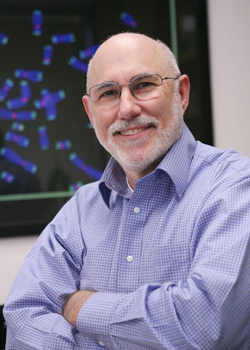 Prof. Jerry W. Shay
Prof. Jerry W. Shay
Jerry W. Shay is the Vice Chairman of the Department of Cell Biology at The University of Texas Southwestern Medical Center in Dallas, an Associate Director of the Harold Simmon's NCI Designated Comprehensive Cancer Center, and holds the Southland Corporation Distinguished Chair in Geriatrics Research. He is also the Program Director of the Cancer Biology Graduate Program at UT Southwestern and holds the title of Distinguish Teaching Professor. In 2012 he was awarded a University of Texas Regent’s Outstanding Teaching Award, in 2013 the Minnie Stevens Piper Foundation Professor Award, and in 2015 the Distinguished Basic Science Educator Award. In 2016 the May Kay Foundation established a Distinguished Professorship in Cancer Research in honor of Dr. Shay and in 2017 Dr. Shay was awarded the Eunice Kennedy Shriver NIH Alliance Pioneer Award.
Dr. Shay’s seminal work on the relationships of telomeres and telomerase to aging and cancer is well recognized. He was placed in the Institute for Scientific Investigations as one of the most highly cited scientists in the field of "Molecular Biology and Genetics". Science Watch placed Dr. Shay into the Doctors of the Decade list and he was ranked as one the most cited authors in the area of General Biomedicine (h-index =108). He was also included in a list of highly influential biomedical researchers (Eur. J. Clin. Inves. 43(12):1339-65). Dr. Shay has received numerous research awards including the Allied Signal Award, the Ted Nash Foundation Award, the American Association of Aging Hayflick Award, and was also named an Ellison Medical Foundation Senior Scholar.
Dr. Shay and his colleagues best known for developing the TRAP assay for measuring telomerase that is used worldwide and has characterized its distinctive mechanism of action in a large number of different tumor types. In addition to 26 issued patents on his cancer-related research, Dr. Shay has published over 500 scientific articles, written 90 book chapters and edited 10 books. Today, Dr. Shay will give us an update on recent advances in telomeres and telomerase research in relation to aging and cancer that are ongoing in his lab.
【ABSTRACT】
Recent Advances in Telomeres and Telomerase in Relation to Aging and Cancer:
TeSLA, TPE-OLD and 6-thio-2'-deoxyguanosine
Jerry W. Shay
University of Texas Southwestern Medical Center
Dallas, Texas USA
This lecture will cover new areas of research in the lab:
1. Telomere Position Effects Over Long Distances (TPE-OLD). We previously documented (Robin et al, Genes & Dev, 2014; Genome Res, 2015) that human genes can be regulated by the length of their telomeres over long distances. This novel mechanism has important explanatory value showing that progressive telomere shortening can change cell physiology and diseases associated with aging without inducing a DNA damage signal. The hTERT gene has been proposed to be regulated by many mechanisms including transcription, alternative splicing, promoter mutations, and by epigenetic changes but a comprehensive understanding of telomerase regulation is incomplete. Our recent studies were stimulated by the observation that large long-lived species including higher primates have the TERT gene positioned very close to the telomere but most short-lived and small mammals have a more centromeric location of the TERT gene. Based on this initial observation we investigated and now provide support for a new control mechanism for the regulation of hTERT that is determined by the length of telomeres PloS Biology, 2016).
2. A telomerase-mediated small molecule, 6-thio-2'-deoxyguanosine (6-thio-dG), results in cancer growth inhibition and cell death. 6-thio-dG is a modified nucleoside and induces telomere dysfunction by preferentially using telomerase to incorporate an altered base into telomeric repeats. Incorporation of 6-thio-dG into telomeres disrupts the binding of shelterin proteins to telomeres resulting in genomic and telomeric DNA damage and rapid cell death but only in cells that express telomerase. We tested the effects of 6-thio-dG on the viability of ~80 non-small lung cancer cell lines (NSCLCs) and found that only 4 were intrinsically resistant to 6-thio-dG. Since most chemotherapies for advanced cancer patients fail due to drug acquired resistance, we tested if 6-thio-dG would be effective in treating chemotherapy resistant melanoma and lung cancers. We observed that multi-drug resistant cell lines and patients derived cells resistant to immunotherapy remained sensitive to 6-thio-dG induced cell killing suggesting the utility of 6-thio-dG as an effective salvage therapy.
3. TeSLA (Telomere Shortest Length Assay). This is a modification of STELA (Single Telomere Length Assay) that detects all the very shortest telomeres in cells. Pros and cons of all telomere measurement techniques will be discussed.